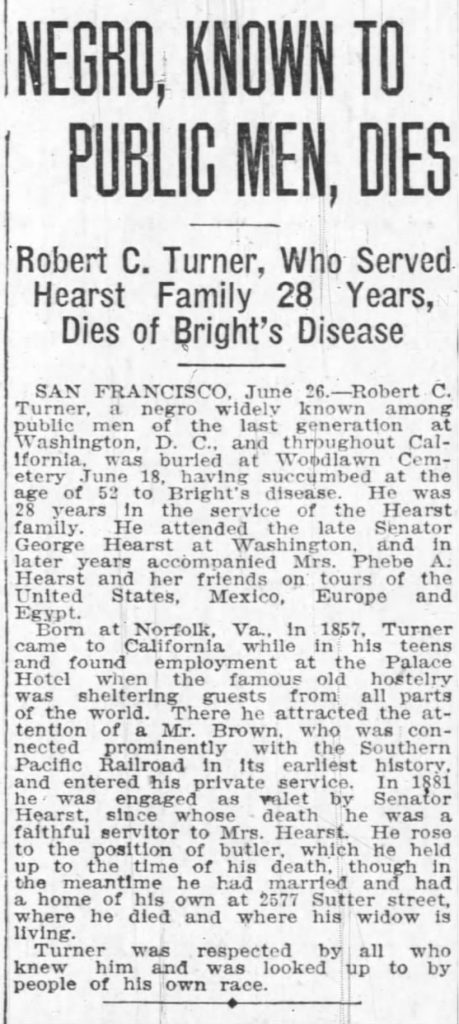Robert Turner passed away at the age of 52 on June 15, 1909. The Oakland Tribune ran Robert’s obituary on the front page of its Sunday edition, getting some of the facts of his life correct, with the exception of his birth date:
`Abdu’l-Bahá wrote a tablet to Ali Kuli Khan in Robert’s honor after his passing:
He was in truth most devoted. Gracious God! What a shining candle was lighted within that black-coloured lamp. Praise be to God that this candle ascended from its earthly lamp unto the immortal Kingdom, to gleam and shine in the assemblage of heaven. Praise be to God that ye adorned his blessed finger with the ring bearing the inscription “I came forth from God, and return unto Him”. This too is a proof of his devotion; with his last breath he was aided to say “Alláh-u-Abhá” and stir thereby the hearts of those present.
In the same tablet, `Abdu’l-Bahá revealed a touching prayer for Robert:
O Thou Provider, O Thou Forgiver! Exalt dearly loved Robert in Thy Kingdom and, in the garden of the Abhá Paradise, make him an intimate of the birds of the meadow. O All Knowing God! While that innocent soul was black in colour, he was, like unto the black pupil of the eye, a source of radiant light. O Thou Forgiving Lord! Enable that yearning soul to behold Thee and cause that thirsty one to drink his fill of the water of life. Thou art the Bestower, the Pardoner, the Loving.
When `Abdu’l-Bahá visited and traveled through North America for eight months in 1912, he spent three days with Phoebe Hearst at her California ranch. There, he learned that another African American Bahá’í and former Hearst employee named Charles Tinsley longed to see him, but could not attend because he was bedridden with a broken leg at his home in San Francisco.
`Abdu’l-Bahá immediately went to visit Tinsley, cheering him immensely, and actively demonstrating his love for the African American believers.
If Robert Turner had lived a few more years, he probably would have seen `Abdu’l-Bahá again in California. It is not difficult to imagine, given the Master’s visit with Mr. Tinsley, that their reunion would have been a joyous one.
After `Abdu’l-Bahá’s ascension in 1921, Shoghi Effendi named Robert Turner as one of the 19 Disciples of `Abdu’l-Bahá, an immortal honor in the Bahá’í tradition of the Báb’s 19 Letters of the Living and Bahá’u’lláh’s 19 Apostles.
Robert Turner passed into eternity in 1909, which means that no one alive today ever knew him. Some might expect, at this point, that Robert would have joined the billions of forgotten souls who have left this temporary material existence without much remaining trace or distinction. But in a remarkable, roundabout way, Robert Turner’s family burial place, once an unmarked grave, has now started to become a pilgrimage destination for Bahá’ís and others, a revered spot where those who know about his inner spiritual life and his impact on the world come to pay their respects and pray for the progress of his soul in the next realm.
His resting place is within sight of and just a short distance from the Hearst mausoleum, which contains the graves of George, Phoebe, and William Randolph Hearst. In death, they all carried only their souls to the next world. In death, they are all equal. In death, they have each ascended to the same source of light and life.
In death, Robert Turner lives.

